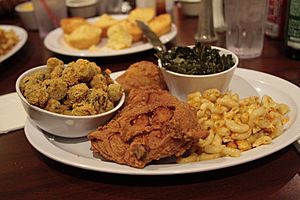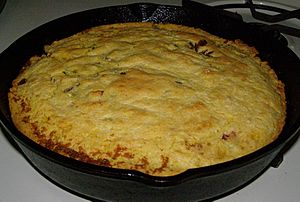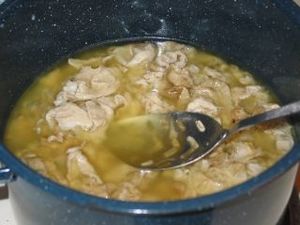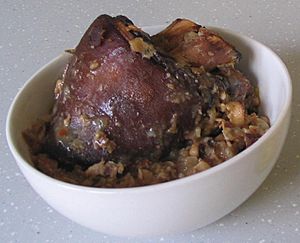Soul food facts for kids
Soul food is a special type of cooking traditionally made and enjoyed by African Americans. It started in the Southern United States. This food style came from what Black slaves were given to eat on Southern farms long ago. But it was also greatly shaped by the cooking traditions of people from West Africa and Native Americans.
Because African Americans have lived in the South for a long time, soul food is strongly connected to the food of the American South. Today, it's a well-known and celebrated part of American food culture. The name "soul food" became popular in the mid-1960s. At that time, "soul" was a common word used to describe African-American culture.
Contents
The Story of Soul Food

The term soul food became popular in the 1960s and 1970s. This was during the Black Power movement, a time when African Americans fought for their rights and identity. One of the first times "soul food" was written down was in The Autobiography of Malcolm X in 1965.
People who moved from the South to northern cities during the Great Migration found that soul food reminded them of home. Soul food restaurants were often owned by Black people. They became important places for people to meet, socialize, and eat together in their neighborhoods.
The recipes for soul food dishes go back even before slavery. They mix cooking styles from West Africa and Europe, adapted to the Southern environment. Many key soul food dishes came from the small amounts of food given to enslaved people. They usually received cornmeal and pork each week. From these basic foods came staples like cornbread, fried catfish, barbecued ribs, chitterlings, and neckbones.
Enslaved people often ate a lot of cooked greens like collards and sweet potatoes. They needed high-calorie meals because they worked long, hard days. This led to cooking methods like frying foods and breading meats with cornmeal. They also mixed meats with vegetables, for example, adding pork to collard greens. Over time, this cooking style was adopted into the wider Southern culture.
Poor white and Black people in the South often cooked similar dishes. However, their cooking styles could be different. Many cooking methods in soul food and Southern cooking, like frying meat and using all parts of an animal, are also found in ancient cultures worldwide.
Soul food also came to northern cities like Washington D.C. through private chefs. Many U.S. Presidents hired Black chefs, especially those with Creole cooking backgrounds. For example, President Benjamin Harrison hired a Black woman named Dolly Johnson as his cook. President Lyndon B. Johnson had a close relationship with his cook, Zephyr Wright. Her experiences with segregation helped him fight for civil rights.
Native American Contributions
Native American cultures in the South, like the Cherokee and Choctaw, greatly influenced Southern cooking. One of the most important foods they shared was corn. Corn was ground into meal or treated to make hominy.
Corn was used in many ways, from making cornbread and grits to liquors like moonshine and whiskey. Many fruits also grew in this region, such as blackberries and muscadines. These were part of Native American diets.
Native Americans, Africans, and Europeans in the South also ate meat from hunting local animals. Common game included opossums, rabbits, and squirrels. They also raised cattle and hogs, which came from Europe.
When an animal was killed, every part was used. People ate not just the meat but also organs like brains, livers, and intestines. This tradition continues today with dishes like chitterlings (hog intestines) and livermush (made from hog liver). Animal fat, especially from hogs, was used for cooking and frying. Early European settlers learned these cooking methods from Native Americans, which helped spread these dishes.
African Cooking Styles
Experts have found a strong African influence in soul food recipes, especially from West and Central Africa. This influence can be seen in how spicy many soul food dishes are. Peppers like malagueta pepper and red (cayenne) peppers were used.
Many foods important in Southern and soul food cooking were first grown or eaten in the African savanna and tropical regions. These include pigeon peas, black-eyed peas, okra, and sorghum.
A type of rice was also grown in Africa. So, many Africans brought to the Americas already knew how to cook rice. Rice is a main side dish in areas like the Lowcountry and Southern Louisiana. It's central to dishes like jambalaya and red beans and rice.
There are many similarities between West African cooking and soul food. Eating sweet potatoes in the U.S. is like eating yams in West Africa. African Americans often eat cornbread, which is similar to how West Africans use fufu to soak up stews.
West Africans also cooked meat over open fires. It's possible enslaved Africans brought this knowledge with them. They might also have learned it from Native Americans, who also used barbecuing.
Researchers say many African tribes ate mostly plant-based diets because it was simple. Food was often served from empty gourds. They used techniques like roasting, frying with palm oil, baking in ashes, and steaming in leaves to change the flavor of foods like nuts, seeds, and rice.
Soul Food Cookbooks

For a long time, it was against the law for enslaved people to learn to read or write. Because of this, soul food recipes and cooking methods were usually passed down by word of mouth. This continued until after slavery ended.
The first soul food cookbook is thought to be What Mrs. Fisher Knows About Old Southern Cooking by Abby Fisher, published in 1881. Another early book, Good Things to Eat, came out in 1911. Its author, Rufus Estes, was a former slave who worked for the Pullman railway. Many other cookbooks were written by Black Americans then, but most are now lost because they weren't widely shared.
Since the mid-1900s, many cookbooks about soul food have been published. A famous soul food chef was Edna Lewis. She wrote several books between 1972 and 2003, like A Taste of Country Cooking. In her books, she shared stories from her childhood while giving recipes for "real Southern food."
Another important soul food cookbook is Vertamae Grosvenor's Vibration Cooking, or the Travel Notes of a Geechee Girl (1970). This book focused on cooking from the South Carolina Lowcountry and Gullah region. It emphasized cooking by "vibration" (feeling) rather than exact measurements. This showed the true spirit of traditional African-American cooking. The simple, healthy ingredients like shrimp, oysters, fresh produce, rice, and sweet potatoes made it a bestseller.
Many religious groups and organizations like the National Council of Negro Women (NCNW) have also created cookbooks to raise money. The NCNW published The Historical Cookbook of the American Negro in 1958. They later released popular cookbooks with recipes from famous Black Americans, such as The Black Family Reunion Cookbook (1991).
Why Soul Food Matters
Soul food started in the Southern U.S. and is eaten by African Americans across the country. Traditional soul food cooking is seen as a way enslaved Africans passed their traditions to their children. It's a cultural creation that came from slavery, mixed with Native American and European influences.
Soul food recipes are popular in the South because the ingredients are easy to find and affordable. Also, African Americans and white Americans lived close to each other during slavery and after.
Experts say that while white Americans provided some of the ingredients, the cooking methods in many soul food dishes were clearly influenced by enslaved Africans. Dishes made by slaves often had many vegetables and grains. This was because slave owners thought too much meat would make slaves tired and less able to work.
The many vegetables found in Africa were replaced in Southern dishes with new leafy greens like dandelion, turnip, and beet greens. Pork, especially from hogs, was added to dishes. Parts like cracklings from the skin, pig's feet, chitterlings, and lard were used to add fat to vegetable dishes. Spices like thyme and bay leaf, mixed with onion and garlic, gave dishes their unique taste.
Some people, like Elijah Muhammad and Dick Gregory, spoke out against soul food. They felt it was unhealthy and harmful to African Americans. They saw it as a reminder of oppression that should be left behind. However, many African Americans were upset by the idea of giving up pork, as it's a key ingredient in many dishes.
Stokely Carmichael also argued that soul food wasn't truly African food because it had European influences. Despite these views, many in the Black Power Movement felt soul food was something African Americans should be proud of. They used it to show that African Americans had their own unique culture and cuisine.
The magazine Ebony Jr! helped teach middle-class African-American children about the cultural importance of soul food dishes.
Soul food is often served at important community events like funerals, family gatherings, Thanksgiving, and Christmas. It has also appeared in popular culture, like the 1997 film Soul Food and the 1995 rap album by Goodie Mob.
Health and Soul Food
When soul food is made traditionally and eaten in large amounts, it can sometimes be unhealthy. People who don't support soul food have talked about health concerns since the name became popular.
Soul food has been criticized for having a lot of starch, fat, sodium, and calories. The ingredients, like salted pork and cornmeal, were often inexpensive. Because of this, some people link soul food to higher rates of high blood pressure, type 2 diabetes, and heart problems in African Americans.
However, some critics and traditionalists argue that trying to make soul food healthier also makes it less tasty. They also say it makes the food less culturally real.
An important part of traditional soul food cooking was reusing cooking lard. Many cooks couldn't afford new shortening, so they would save the melted grease in a container. Once it cooled and became solid again, they could use it for cooking another time.
Today, with new ideas about "healthy" eating, some cooks use different methods. They might use liquid oils like vegetable oil for frying. They might also use smoked turkey instead of pork. Also, hog farming has changed, so pork is much leaner now than it used to be. Some cooks even use vegetarian options like tofu in their recipes.
Many ingredients in soul food actually have good health benefits. Collard greens and other greens are full of vitamins (like A, B6, K, and C) and minerals (like manganese, iron, and calcium). They also have fiber and some omega-3 fatty acids. These greens contain special plant nutrients that might help prevent certain cancers.
However, traditional ways of cooking greens often involve high heat or slow cooking. This can cause water-soluble vitamins to be lost into the cooking water. This water, called pot liquor, is often consumed.
Peas and legumes are affordable sources of protein. They also have important vitamins, minerals, and fiber.
Images for kids
See also
 In Spanish: Soul food para niños
In Spanish: Soul food para niños







